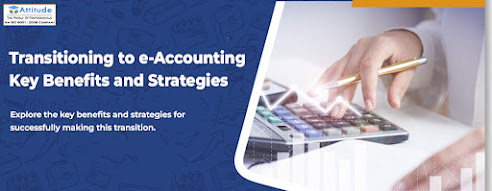Transitioning to e-Accounting: Key Benefits and Strategies
Introduction
In the ever-evolving landscape
of finance and accounting has become more than just an option; it's a necessity
for businesses aiming to stay competitive and efficient in the modern era.
E-accounting
tools and digital financial management strategies can significantly
streamline financial processes, enhance data accuracy, and offer various
benefits that can transform your business operations. In this blog, we will
explore the key benefits and strategies for successfully making this
transition.
Benefits of Transitioning to
e-Accounting:
Enhanced Efficiency:
E-accounting automates repetitive tasks, reducing manual data entry and the
likelihood of human errors. This efficiency allows finance teams to allocate
more time to analytical tasks and decision-making.
Improved Accuracy: Digital
financial management ensures greater accuracy in financial data, reducing the
chances of errors associated with manual calculations and data handling. This
heightened accuracy is essential for compliance and informed decision-making.
Real-time Data Access: With
e-accounting tools, businesses can access real-time financial data, providing
immediate insights into their financial health. This agility enables quicker
reactions to market changes and opportunities.
Cost Savings:
Transitioning to financial management can lead to cost savings by reducing the
need for physical storage, paper-based transactions, and extensive labor hours
spent on traditional accounting processes.
Enhanced Security:
E-accounting systems often incorporate robust security measures to protect
sensitive financial data. This is crucial in an age where cybersecurity threats
are on the rise.
Scalability:
financial management tools can be tailored to suit the size and complexity of
your business. As your business grows, these systems can adapt to your evolving
needs.
Strategies for a Successful
Transition:
Define Your Goals:
Before implementing e-accounting tools, establish clear objectives. Determine
what you want to achieve, whether it's reducing processing time, enhancing
reporting, or improving compliance.
Assess Current Processes: Evaluate
your current accounting processes to identify areas that could benefit from
automation and digital solutions. Understanding your existing workflows is
crucial for a smooth transition.
Choose the Right Tools:
Select e-accounting systems that align with your business needs and goals.
Consider factors like scalability, user-friendliness, and integration
capabilities.
Training and Onboarding:
Provide adequate training and support to your finance team to ensure they are
comfortable with the new tools. This can reduce resistance to change and
accelerate the adoption process.
Data Migration: Plan
a seamless data migration process to ensure all historical financial data is
properly transferred to the new system, preserving the integrity of your
financial records.
Security Measures:
Implement robust security measures to protect sensitive financial data from
cyber threats and unauthorized access. This is essential in maintaining trust
and compliance.
Continuous Monitoring:
Regularly monitor the performance of your e-accounting tools and financial
management systems. Ensure they are aligned with your objectives and are being
used to their full potential.
In conclusion
Transitioning to e-accounting
and embracing digital
financial management is a strategic move for businesses looking to thrive
in the digital age. The benefits of enhanced efficiency, accuracy, and
real-time data access make it a worthwhile investment. By following the right
strategies and selecting the appropriate tools, your business can successfully
make this transition and stay ahead in today's competitive financial landscape.




Comments
Post a Comment